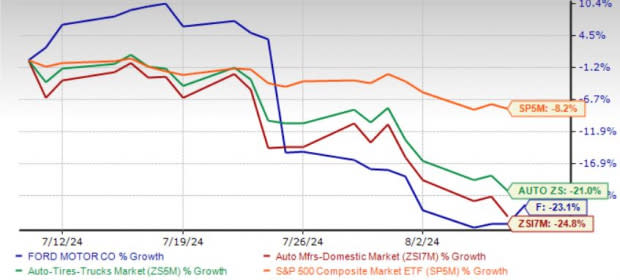Shares of the U.S. legacy automaker Ford F have tumbled nearly 23% in the past month, primarily due to dismal second-quarter results. Since its latest earnings report on Jul 24, Ford has seen its stock plummet 24.7% as earnings per share missed expectations, and net income contracted more than 5% year over year to $1.8 billion.
A rise in warranty and vehicle recall expenses hit the automaker’s profits hard. These costs reached a staggering $2.3 billion in the second quarter alone, up $800 million and $700 million on a sequential and yearly basis, respectively. Ongoing quality issues have been increasing Ford’s warranty costs for years, but the massive surge in the second quarter seems to have really spooked investors.
In contrast, General Motors GM, Ford’s closest competitor, reported better-than-expected second-quarter earnings and sales and even raised its full-year guidance for EPS and free cash flow (FCF). While Ford did boost its adjusted FCF guidance for 2024, it maintained its profit outlook, which left some investors disappointed, hoping for a more optimistic forecast.
As investors weigh Ford’s historical resilience against its current setbacks, the question arises whether now is the opportune time to invest in Ford, taking advantage of the recent share price dip. To answer that, let’s delve deeper into the potential drivers and headwinds that could shape the company’s future.
Price Performance Over a Month

Image Source: Zacks Investment Research
Ford Pro: A Beacon of Strength
One of Ford’s brightest spots in the second quarter was its commercial vehicle division, Ford Pro. This segment delivered an impressive operating margin of 15.1%, the highest among all Ford’s divisions. The robust demand for Super Duty trucks and Transit commercial vans, supported by a healthy order book, drove the segment’s performance.
The successful launch of the all-new Super Duty has set a strong foundation for future growth. To capitalize on the rising popularity of Super Duty trucks, Ford recently announced plans to add a third assembly plant in North America, increasing production capacity by 100,000 units starting in 2026.
The company has raised the EBIT forecast of Ford-Pro unit from $8-$9 billion to $9-$10 billion amid continued strength across all three domains: vehicles, software and physical services.
Ford’s increasing focus on software technology and services business will be a major driver. CEO Jim Farley highlighted on the latest earnings call that Rivian RIVN, Tesla TSLA, and Ford are the only OEMs outside of China with control over software across all vehicle domains.
Ford’s paid software subscriptions grew 40% in the quarter, reaching more than 765,000, with integrated service revenues set for double-digit growth this year. The company is targeting $1 billion in software revenues next year, with 50%+ gross margins, largely driven by Ford Pro. By 2026, Ford Pro is expected to contribute 20% of the company’s overall EBIT.
Ford Model e: A Drag on F’s Overall Profits
While Ford Pro has been a strong performer, the company’s electric vehicle (EV) division, Ford Model e, has been a significant drag on overall profits. In the second quarter, the Ford Model e business incurred a loss of $1.1 billion due to lower sales volumes, pricing pressure and high manufacturing costs. Ford anticipates the full-year loss from the Model e unit to range between $5 billion and $5.5 billion amid continued pricing pressure and increased investments in next-generation EVs.
This underperformance in the EV segment is a critical concern for Ford’s overall profitability. The Zacks Consensus Estimate for Ford’s EPS in 2024 is pegged at $1.90, implying a 5.5% year-over-year decline. Additionally, earnings estimates for 2024 and 2025 have been revised downward over the past 30 and seven days, indicating a lack of confidence in the company’s near-term prospects.

Image Source: Zacks Investment Research
Assessing Ford’s Path Forward
Despite the challenges in the EV segment, Ford Pro’s strong performance is expected to offset some of these losses. However, the company has also reduced its operating profit forecast for the Ford Blue segment, which includes traditional internal combustion engine models, due to ongoing quality issues. Ford’s overall EBIT guidance for 2024 remains within the range of $10-$12 billion.
Financially, Ford ended the second quarter with approximately $27 billion in cash and $45 billion in liquidity, an increase from $25 billion in cash and $43 billion in liquidity at the end of the first quarter. The company also remains on track to deliver $2 billion in material, manufacturing, and freight efficiencies over the full year. Additionally, Ford has raised its adjusted FCF projection for the year by $1 billion to a range of $7.5-$8.5 billion.
However, the road ahead for Ford is far from smooth. Ford needs to improve vehicle quality, reduce complexities, cut warranty and recall costs, and turn around its EV business. The company has indicated that most warranty issues stem from older models and that it is actively improving the quality of its newer models. However, it may take 12 to 18 months before these efforts begin to reduce warranty costs. Unfortunately, this means that Ford could continue to face elevated warranty expenses for some time.
What Does Ford’s Valuation Suggest?
Ford’s valuation remains attractive. The company trades at a forward sales multiple of 0.24, lower than the industry average and its own five-year average, earning it a Value Score of A.

Image Source: Zacks Investment Research
Last Word
While Ford’s valuation is appealing and its Ford Pro division is performing well, the company faces substantial internal challenges. High warranty and recall costs and lower-than-expected EV demand present significant hurdles for the company. Farley and his team face an uphill battle in steering Ford through these challenges, especially as the company works to turn around its struggling Model e division.
For new investors, it may be prudent to adopt a wait-and-see approach, while existing shareholders might consider holding onto their shares as the company navigates these headwinds.
Ford currently carries a Zacks Rank #3 (Hold). You can see the complete list of today’s Zacks #1 Rank (Strong Buy) stocks here.
Want the latest recommendations from Zacks Investment Research? Today, you can download 7 Best Stocks for the Next 30 Days. Click to get this free report
Ford Motor Company (F) : Free Stock Analysis Report
General Motors Company (GM) : Free Stock Analysis Report
Tesla, Inc. (TSLA) : Free Stock Analysis Report
Rivian Automotive, Inc. (RIVN) : Free Stock Analysis Report
To read this article on Zacks.com click here.
EMEA Tribune is not involved in this news article, it is taken from our partners and or from the News Agencies. Copyright and Credit go to the News Agencies, email news@emeatribune.com Follow our WhatsApp verified Channel





